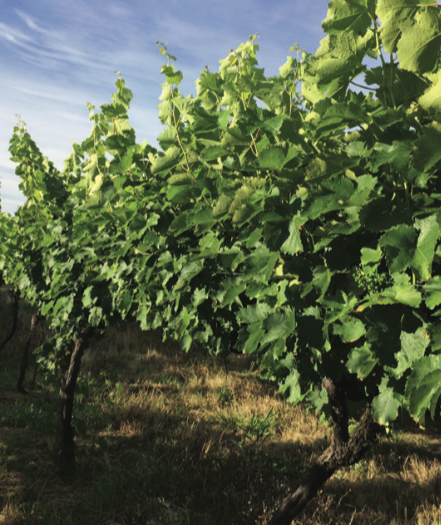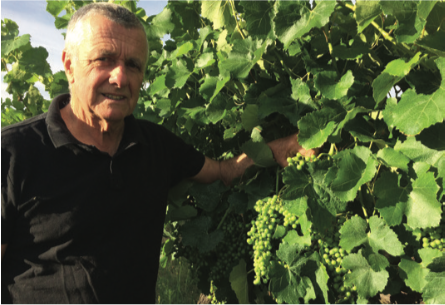By Brian Freeman, Freeman Vineyards, Hilltops, New South Wales
First published in the January/February 2017 issue of the Wine & Viticulture Journal

Back in the seventies, some of Young’s early vignerons must have been dreaming of gloriously sweet seductive Tokay (Tokaji), the wine style most always associated with Hungary. That can surely be the only explanation for the rare plantings of both Harselevelu and Furmint at Peter Robinson’s foundation Hilltops vineyard at Barwang, purchased by McWilliam’s in 1989.
Enter grapegrower Laurie Dolderson who established one of the first vineyards in the Hilltops GI, the Hercynia estate, set high on a 560-metre ridge 11km from Young. His son Keith worked in the Barwang vineyard and it seems he purloined some cuttings to establish just two rows – one Furmint, the other Harslevelu – at the Dolderson’s Prunevale vineyard.
These cheeky immigrants put down roots alongside rows of Chardonnay and Sauvignon Blanc, and eventually passed to Freeman Vineyards in 2004 when we acquired the adjoining Dolderson property on our northern boundary.
The two Hungarian origin varieties don’t quite fit the Freeman ‘Italian inspired portfolio’ story, but that hasn’t deterred us from experimenting with both.
According to Jancis Robinson, Harslevelu (meaning ‘linden leaf’) is best noted for the fact it contributes ‘smoothness and spicy character’ to Tokay, the wine style synonymous with Hungary. It is more overtly aromatic than its companion, the white flagship grape Furmint.
The origins of Harslevelu (also known as Lipovina in neighbouring Slovenia and Lindenblättriger in Germany) are said to date to the 16th century in the Carpathian Basin, but its footprint is particularly associated with the region of Somlo in Hungary’s northwest. Its heartland is Tokay – home of those famed Hungarian dessert wines – but it is also grown in Slovakia and Austria’s Burgenland.
Wikipedia also claims Harslevelu is found in South Africa, but no mention of any other sites. Clearly, those valiant first two rows on the Freeman estate don’t rate on Wikipedia’s radar.
Nor, apparently, do the WA Department of Primary Industry trials of Harslevelu in Manjimup, WA (2003-2011) where researchers noted the erect growth and large, long, loose bunches with wide shoulders and an average yield/vine of 6.4kg, which required substantial crop thinning. The WA trials on fruit flavour spectrum displayed peaches, lychee and lemony citrus flavours.
According to Jancis Robinson, pure Harslevelu is typically green-gold, viscous and full-flavoured with nuances of its namesake, linden honey.
By contrast, Furmint’s origins date back to the 13th century and the Tartar invasion of what eventually became the Tokay region. It was called ‘froment’ after its wheat-gold colour, a wine style that Robinson describes as higher in acid and ‘sturdy with real fire.’ It is also sometimes called Sipon, or Posip on the Dalmatian coast.
Furmint, a thin-skinned variety that buds early and rots nobly, has always been the dominant variety in the legendary sweet wines of Tokay. The best contemporary exponents of the dry, higher acid framed style arguably emanate from Austria exemplified by the Wenzel Furmint.

RARE VINES
It’s rather premature to contrast our Hilltops Harslevelu and Furmint trials to either its Magyar origins or the Manjimup research, but the initial harvests are proving encouraging.
Since the Hercynia vineyard was acquired in 2004, the original two rows have gradually been expanded to 12 rows (just under one hectare), established on VSP trellising on typical well-draining Hilltops red granitic loam soils. The elevation is 560 metres and row orientation north-south. From the outset the vines have been spur-pruned.
Both varieties display a characteristic erect growth profile, Furmint producing slightly more upright canes than the Harslevelu. The Furmint bunches are large and tight with large, thin-skinned berries, and consequent susceptibility to botrytis development.
By contrast, Harslevelu is even more prolific producing a large number of loose bunches with slightly smaller berries than the Furmint, that are more tolerant to fungal risks.
Depending on the season we irrigate to mitigate vine stress in dry/ hot conditions. Regardless of the prevailing water management regime, the impressively high yields of both grape varieties tend to inhibit growth towards the end of most seasons. But there is still a need to crop thin to achieve desirable yields of 10-15 tonnes per hectare.
The Hungarian block sees budburst in mid-September, flowering in early November and progresses to veraison in mid-January. Harvest comes typically after the classic white varieties – Sauvignon Blanc and Chardonnay – at the end of March.
EXPERIMENTAL WINES
By the time this issue is released we will have bottled the first vintage of Freeman’s homage to Hungary – a blend of both Furmint and Harslevelu. Unlike its traditional Hungarian forebears, it is a textural dry wine. Picked at 13 Baumé, with a pH of 3.5 and low acid (6g/L) the grapes are destemmed before natural fermentation in stainless steel for two weeks, then left on skins and plunged and pressed-off after a further two weeks skin contact.
The inaugural wine displays floral aromatics and tropical lychee, pear and citrus fruit nuances complemented by bright acidity and a textural, mellow palate.
According to wine writer Matt Walls, unoaked Furmint is a bit of a “white grape supergroup”. He highlights its composite likeness to the pungent aromatics of Sauvignon Blanc, the richness of Chardonnay, and the minerality of Riesling.
And I am inclined to agree. Adding Harslevelu to the blend adds even more complexity to this fascinating amalgam.
Another Freeman trial is being conducted to explore a classic sweet wine, more in the Tokay mould. We pick both varieties at 11 Baumé and ferment a dry wine, which is subsequently added to the naturally botrytised grapes for a one-month soak, then pressed off to old oak barrels where it currently rests.
Both these wines show real promise, and stand testament to the two curious Hilltops vignerons who 40 years or so ago first cultivated Furmint and Harslevelu on the rolling western facing slopes near Young.
Once released, the Freeman Furmint Harslevelu blend will only be available from the cellar door.
REFERENCES
Walls, M. (2012) A ferment about Furmint. http://www.timatkin.com/articles?511. Accessed 3 January, 2017.
Robinson, J. (1986) Vines, Grapes and Wines. London, United Kingdom: Mitchell Beazley.
Harslevelu

By Peter Dry, Emeritus Fellow, The Australian Wine Research Institute
Background
Hárslevelű (harsh-leh-veh-loo) is an old variety from Hungary (its earliest mention was in the mid-18th century). DNA analysis has revealed that it is an offspring of Furmint. Harslevelu literally means ‘linden leaf’ in Hungarian. Global area in 2010 was 1856 ha, up 43% from 2000. More than 90% of the area is found in Hungary where it is widely grown but perhaps best known for its blend with Furmint in the sweet Tokaji Aszu wines made from botrytized grapes. Approximately two-thirds of the Hungarian planted area of Harslevelu is found in the north-eastern Tokaj region. It is also important in the regions of Eger (eastern Hungary) and Somló (western). Main synonyms are Budai Feher, Feuille de Tilloul (France), Harslevelue, Harzevelu, Lindenblättrige (Germany, Austria), Lipolist (Croatia) and Lipovina (Czech R., Slovenia). Harslevelu is also grown in Slovakia, Romania and South Africa. The planted area in Australia is tiny: there are at least four wine producers, in WA and NSW.
Viticulture
Budburst is early to mid-season and maturity is mid-season (relatively late for a white variety). Vigour is low in WA but moderate elsewhere and growth habit is erect. Bunches are large and loose with medium berries. Yield is high and yield control may be necessary to achieve adequate ripening. Spur pruning is used in Australia. It is moderately susceptible to both powdery mildew and sunburn. Experience in WA suggests that Harslevelu is more suited to warm than cool climate regions. Good acid retention
Wine
Harslevelu is suitable for both dry and sweet wines—but it is now more often used for the former, even in Hungary. Wines are aromatic, light to full bodied and delicately-spiced. Descriptors include linden honey (in Europe), peach and pear. Acid retention in berries is good and consequently wines typically have a crisp finish. Harslevelu contributes perfume and spice to blends, notably with Furmint in Hungary. Wines have had good consumer acceptance in trials in WA.



















